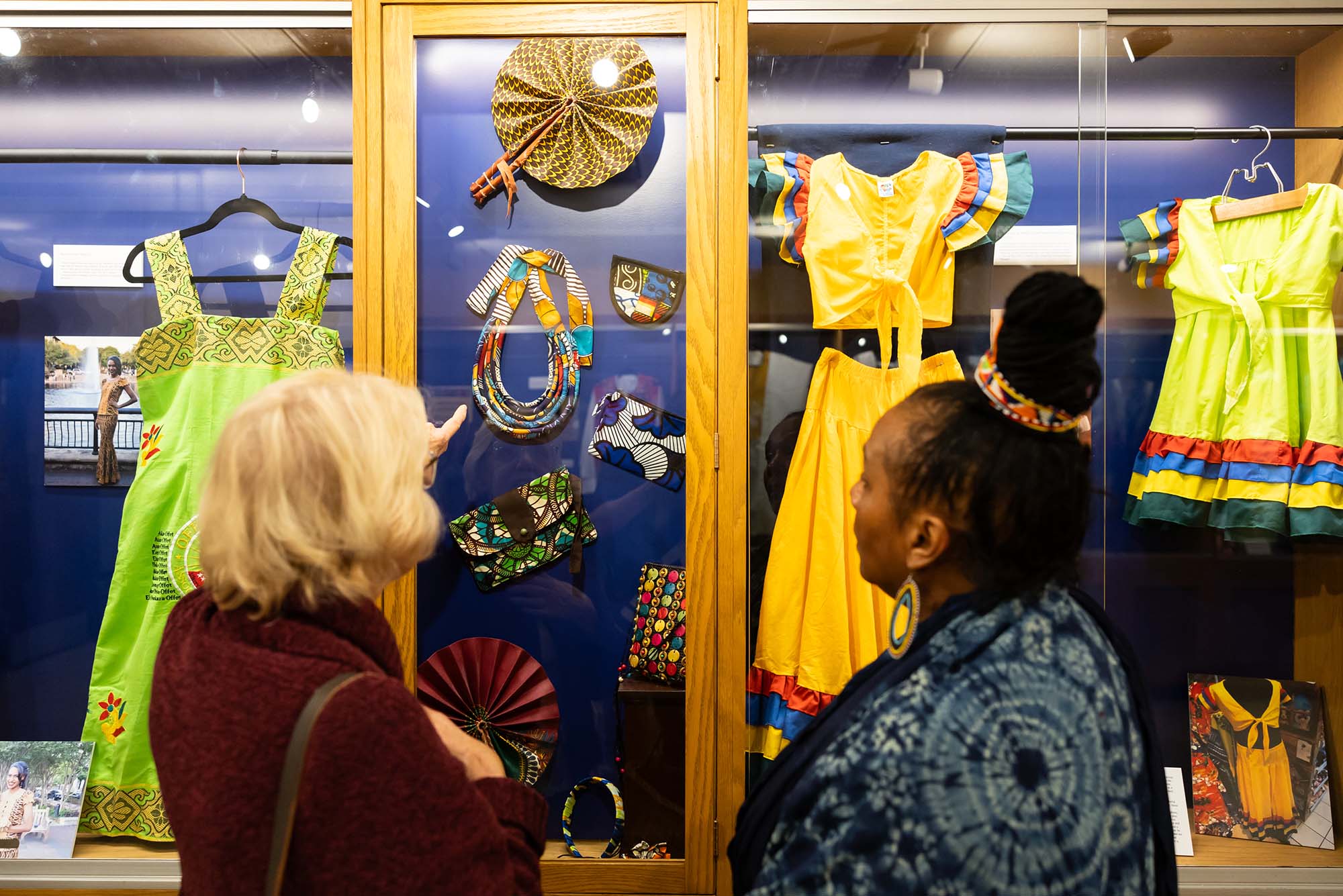Textiles Tell Stories Highlights BU Libraries African Textiles Collection
New exhibition at Mugar Memorial Library reveals the diversity of African culture

Textiles Tell Stories: Exploring the African Studies Library Collection displays BU Libraries’ rich collection of textiles. Photos by Jake Belcher
Textiles Tell Stories Highlights BU Libraries African Textiles Collection
New exhibition at Mugar Memorial Library reveals the diversity of African culture
On a recent Wednesday evening, Mugar Memorial Library looked a little different.
From the back of the library, beyond the rows of students silently studying, emanated the sound of African music and the aroma of plantains and jollof rice. Colorful textiles lined the walls, and the space was humming with BU community members.
The occasion? The opening of the new BU Libraries exhibition, Textiles Tell Stories: Exploring the African Studies Library Collection, which showcases the University’s rich collection of African textiles.
BU’s African Studies Center is one of the country’s oldest leaders in the promotion of African language and related studies. The African Studies Library Collection includes some 218 textiles from 18 countries. The exhibition at Mugar, on view through the end of the year, pairs culturally significant fabrics with text that explains their importance.
Cynthia Becker, a College of Arts & Sciences professor of African art and chair of the history of art and architecture department, helped curate the exhibition.
“Learning about African textiles provides insights into the histories, cultural identities, and political expressions of an extremely diverse continent,” Becker says. “Like books, these fabrics tell stories.”

To bring those stories to life, the exhibition’s pieces are organized according to function. The textiles are displayed as “actors in the world,” notes cocurator Colleen Foran (GRS’20,’26), a PhD candidate in African art.
For example, intricate fabrics are displayed under labels like “Textiles as Optimism” and “Textiles as Identity.” In the “Textiles as Translation” section, a label explains that the Ghanaian Adinkra cloth on display has distinctive symbols associated with specific concepts or proverbs. In the “Textiles as Activism” section, viewers learn about the debate surrounding an ivory mask from the Benin Kingdom, thanks to a 1970s-era textile.
Organizing the individual pieces by theme helps viewers understand a vast topic. With items from South Africa to Nigeria and places in between, the exhibition could have fallen into the trap of sacrificing depth for breadth. Luckily, the Special Collections division of BU Libraries—along with the African Studies Center, the CAS history of art and architecture department, the BU Diversity & Inclusion Learn More Series, and the Fenway Group—have struck a fine balance.

Among the most arresting textiles on display are ones that reveal awe-inspiring stories.
One textile from Mozambique, created in 1990 as that country was grappling with a devastating civil war, is dotted with uplifting messages in Portuguese, like “Peace, Love and Happiness.” Remarkably, the cloth was produced in an area that saw some of the worst violence during the war, says cocurator Beth Restrick, head of the African Studies Library.
“The war was still raging, there was no end in sight yet,” Restrick says. “And yet, this beautiful, bright, optimistic cloth was being produced.”
While the pieces on display range from indigo-dyeing techniques in Nigeria to Eswatini’s independence from England, the exhibition also has a local connection. One of the side rooms features clothing loaned by members of the BU community.
Becker says this complementary exhibition—titled Textiles Tell OUR Stories (on view until May 20)—highlights BU’s large African community.
“Our hope is that when visitors see how people use and wear African textiles in the United States and in their homelands, it makes the textiles more approachable and allows for greater cross-cultural understanding,” she says.

The stories emerging from these garments are deeply personal. For example, two young girls’ cotton Sega dresses illuminate one Mauritanian mother’s efforts to teach her US-born children about their African roots. A man’s Amazigh outfit, featuring a traditional turban and a ceremonial dagger, reveals how he keeps his North African identity alive in Boston.
In addition to collaborations beyond the BU community, such as with Emilie Songolo, MIT Libraries head of Distinctive Collections, students in Becker’s Kongo to Cuba course helped create labels for some textiles.
To convey the cultural richness of these textiles, many of the pieces are accompanied by archival texts and books. Of note: a commemorative textile from Eswatini is accompanied by a 1991 Daily Free Press article announcing the visit of that country’s King Mswati III to BU.
Foran says the show is a way to make students, faculty, and staff more aware of the African Studies Center’s rich collection of materials.
“It’s something that maybe not every single person knows about here in the BU community,” she says. “Having these beautiful, colorful, rich, really engaging textiles is a way to try to raise awareness about all the work that the African Studies Center and libraries do here.”
Textiles Tell Stories: Exploring the African Studies Library Collection is on view at Mugar Memorial Library, first floor, 771 Commonwealth Ave., through the end of the year. The complementary exhibition Textiles Tell OUR Stories is on view until May 20. The free exhibitions are open to members of the BU community. Mugar Memorial Library is open Monday to Thursday, 7 am to 2 am; Friday, 7 am to 11 pm; Saturday, 10 am to 11 pm; and Sunday, 10 am to 2 am.
Comments & Discussion
Boston University moderates comments to facilitate an informed, substantive, civil conversation. Abusive, profane, self-promotional, misleading, incoherent or off-topic comments will be rejected. Moderators are staffed during regular business hours (EST) and can only accept comments written in English. Statistics or facts must include a citation or a link to the citation.